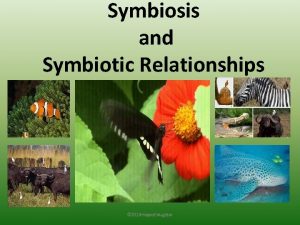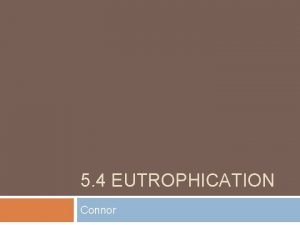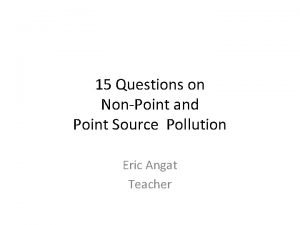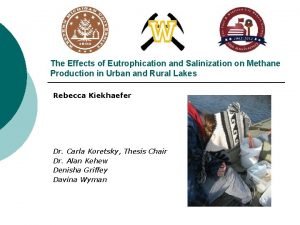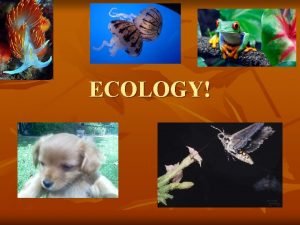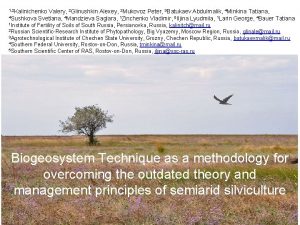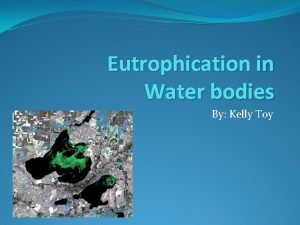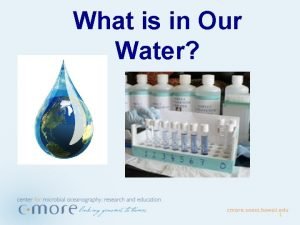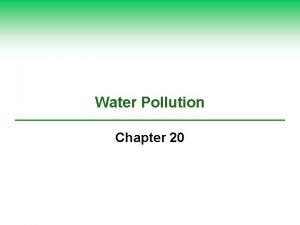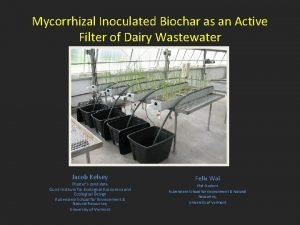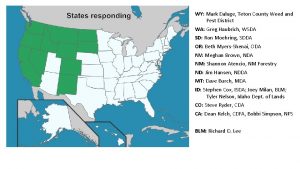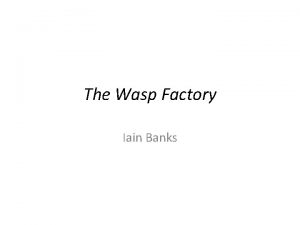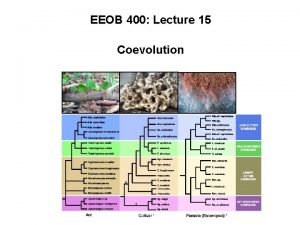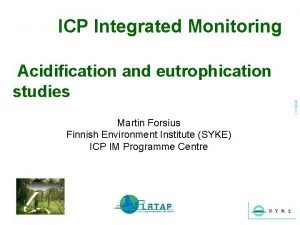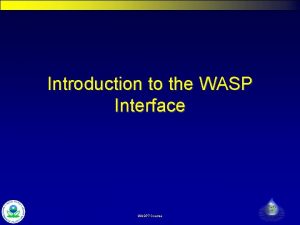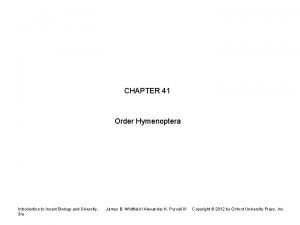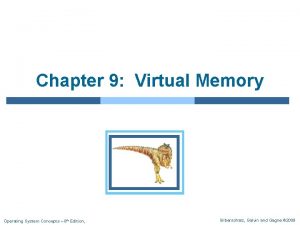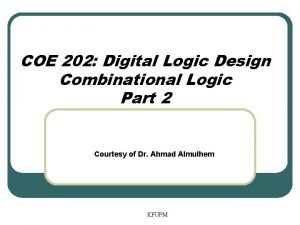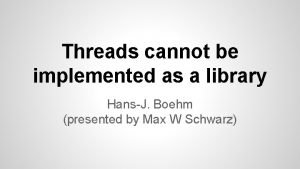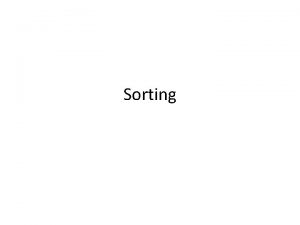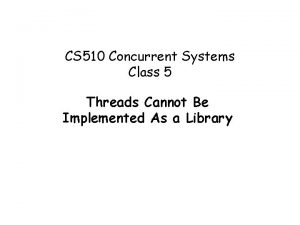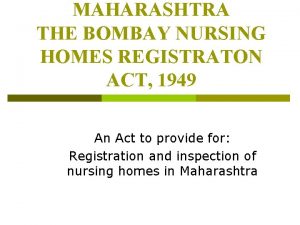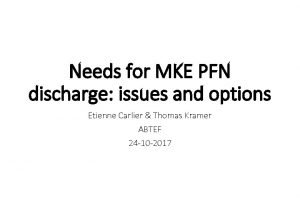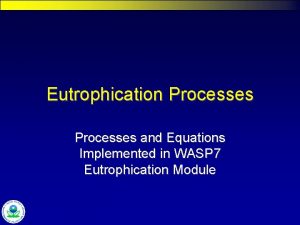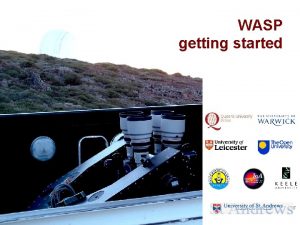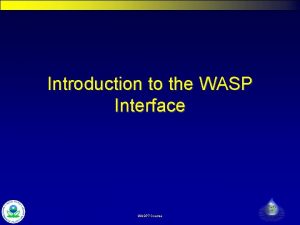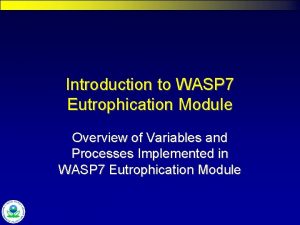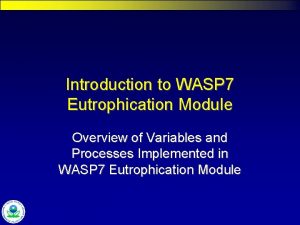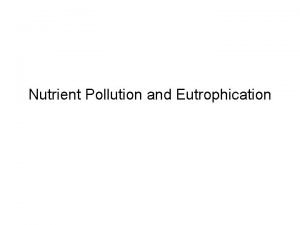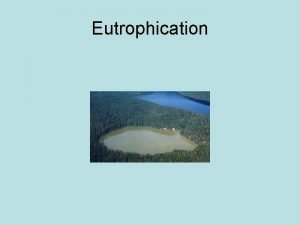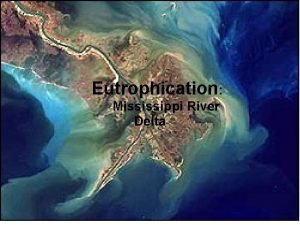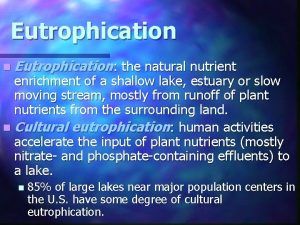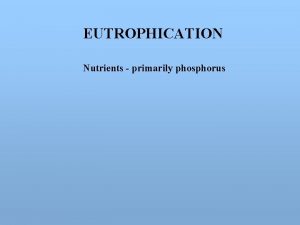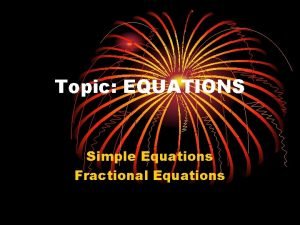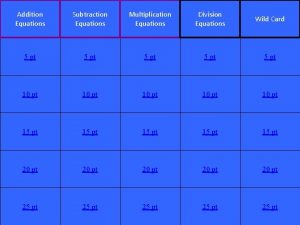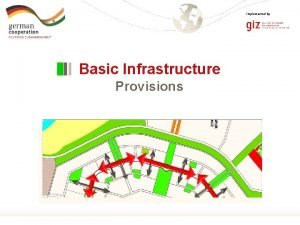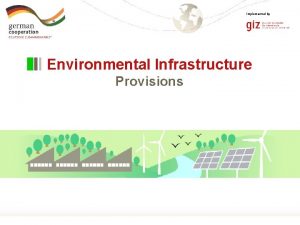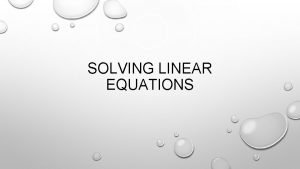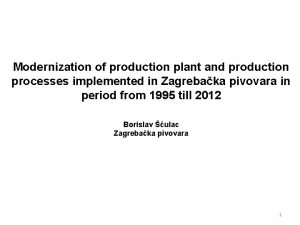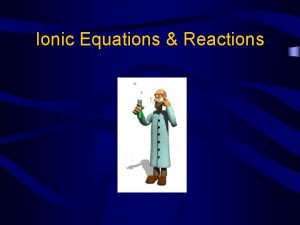Eutrophication Processes and Equations Implemented in WASP 7










































- Slides: 42

Eutrophication Processes and Equations Implemented in WASP 7 Eutrophication Module

Watershed & Water Quality Modeling Technical Support Center DO Periphyton Phytoplankton Photosynthesis atmosphere Reaeration Respiration Death&Gazing Oxidation Detritus C P N CBOD 1 Dis. Org. P Dis. Org. N NH 3 Nitrification Adsorption Mineralization CBOD 2 CBOD 3 PO 4 NO 3 SSinorg Denitrification N 2 Settling

Watershed & Water Quality Modeling Technical Support Center Phytoplankton • The growth rate of a population of phytoplankton in a natural environment: – is a complicated function of the species of phytoplankton present – involves differing reactions to solar radiation, temperature, and the balance between nutrient availability and phytoplankton requirements • Due to the lack of information to specify the growth kinetics for individual algal species in a natural environment, – this model characterizes the population as a whole by the total biomass of the phytoplankton present

Watershed & Water Quality Modeling Technical Support Center Phytoplankton Kinetics Si NO 3 NH 3 Phyt Light O C: N: P PO 4 Where: Cp = phytoplankton carbon concentration (mg/L) RG = growth rate constant (per day) RD = death rate constant (per day) RS = settling rate constant (per day)

Watershed & Water Quality Modeling Technical Support Center Phytoplankton Growth NO 3 NH 3 Phyt Light O C: N: P Growth rate constant: PO 4 Gmax = maximum specific growth rate constant at 20 C, 0. 5 – 4. 0 day-1 XT = temperature growth multiplier , dimensionless XL = light growth multiplier, dimensionless XN = nutrient growth multiplier, dimensionless

Watershed & Water Quality Modeling Technical Support Center Temperature Effects on Phytoplankton Temperature multiplier: where G = temperature correction factor for growth (1. 0 – 1. 1) T = water temperature, C

Watershed & Water Quality Modeling Technical Support Center Light Effects on Phytoplankton

Watershed & Water Quality Modeling Technical Support Center Light Effects on Phytoplankton Integrated over depth: D = average depth of segment, m Ke = total light extinction coefficient , per meter I 0 = incident light intensity just below the surface, langleys/day (assumes 10% reflectance) Is = saturating light intensity of phytoplankton, langleys/day

Watershed & Water Quality Modeling Technical Support Center Light Effects on Phytoplankton

Watershed & Water Quality Modeling Technical Support Center Light

Watershed & Water Quality Modeling Technical Support Center Total Light Extinction • Ke back = background light extinction due to ligands, color, etc. • Ke shd = algal self shading, • Ke solid = solids light extinction • Ke DOC = DOC light extinction,

Watershed & Water Quality Modeling Technical Support Center Light Extinction Components Background: Solids: DOC:

Watershed & Water Quality Modeling Technical Support Center Light Extinction Formulation Algal Self Shading: Options: • Model Calculates (Default) Mult = 0. 0587, Exp= 0. 778 • User Specifies Mult & Exp • Switch Off Self Shading

Watershed & Water Quality Modeling Technical Support Center Phytoplankton Growth, reprise

Watershed & Water Quality Modeling Technical Support Center Nutrient Effect on Phytoplankton

Watershed & Water Quality Modeling Technical Support Center Nutrient Limitation on Growth

Watershed & Water Quality Modeling Technical Support Center Phytoplankton “Death” NO 3 NH 3 Death rate constant: Phyt Light O C: N: P PO 4 k 1 R = endogenous respiration rate constant, day-1 1 R = temperature correction factor, dimensionless k 1 D = mortality rate constant, day-1 k 1 G = grazing rate constant, day-1, or m 3/g. Z-day if Z(t) specified Z(t) = zooplankton biomass time function, g. Z/m 3 (defaults to 1. 0)

Watershed & Water Quality Modeling Technical Support Center Phytoplankton Settling NO 3 NH 3 Phyt Settling rate constant: v. S = settling velocity, m/day AS = surface area, m 2 V = segment volume, m 3 Light O C: N: P PO 4

Benthic Algae or periphyton

Watershed & Water Quality Modeling Technical Support Center Differences Fixed and Floating Plants Floating Attached Yes No Types Diatoms Greens Blue Greens Periphyton Filamentous Algae Rooted Macrophytes Units chl-a/m 3 g. D/m 2 or mg A/m 2 Transport mg Light Average Water Column Light at Bottom Predation Zooplankton Insect Larvae, Snails Substrate Not an Issue Rock vs. Mud

Watershed & Water Quality Modeling Technical Support Center Functional Groups • Periphyton: algae attached to and living upon submerged solid surfaces • Filamentous Algae – Cladophora • Macrophytes: Vascular, Rooted Plants – Myriophyllum, Elodea, Potamogeton

Watershed & Water Quality Modeling Technical Support Center Lakes versus Rivers load transport

Watershed & Water Quality Modeling Technical Support Center “Shallow Stream with Attached Plants” Fixed Plants 100 cf (g. C/m 2 ) 50 0 N, P 2 cn , cp (g. N/m 3 , g. P/m 3 ) 1 0 Organic or “Lost” Fraction co 20 (g. C/m 3 ) 10 0 0 2000 Downstream Distance, m 4000 x

Watershed & Water Quality Modeling Technical Support Center Typical Rates • Maximum growth rate 30 g/m 2/d (10100) • Respiration rate 0. 1/d (0. 05 -0. 2) • Death rate 0. 05/d (0. 01 -0. 5) (During sloughing could be higher) • Nutrient half-saturation constants tend to be higher that phytoplankton by a factor of 10 to 100

Watershed & Water Quality Modeling Technical Support Center Periphyton Model Phytoplankton: Based on Average Light Periphyton: Based on Bottom Light

Watershed & Water Quality Modeling Technical Support Center Effect of Light on Periphyton (a) floating plants (b ) periphyton

Watershed & Water Quality Modeling Technical Support Center Overview of Nutrient Cycling Phytoplankton, C Periphyton, C-dw 1 adc NCRB anc/adc PCRB apc/adc 1 -fon 1 -fop Detr C kdiss OCRB CBODi fon Detr P Detr N kdiss 1 Diss. Org. P kdiss 1 Diss. Org. N Inorganic pool

Watershed & Water Quality Modeling Technical Support Center The Phosphorus Cycle • Inorganic P – DIP taken up by algae (phytoplankton and periphyton) for growth – DIP sorbs to solids to form particulate inorganic P – Particulate inorganic P may settle with inorganic solids • Organic P – during algal respiration and death, a fraction of the cellular phosphorus is recycled to the inorganic pool – the remaining fraction is recycled to the detrital P pool – particulate detrital P may settle out at the same velocity as organic matter (vs 3) – Particulate detrital P dissolves to DOP – DOP mineralizes to DIP

Watershed & Water Quality Modeling Technical Support Center Phosphorus Cycle Phytoplankton 4 Gp. C 4 apc Dp. C 4 apc(1 -fop) PO 4 3 C 3(1 -fd 3) Detr. P 15 Kdiss. C 15 Org. P 8 C 8(1 -fd 8)

Watershed & Water Quality Modeling Technical Support Center Phosphorus Equations • Phytoplankton P Growth Death Settling • Detrital P Death Dissolution Settling

Watershed & Water Quality Modeling Technical Support Center Phosphorus Equations • Dissolved Organic P Dissolution Mineralization • Inorganic P Death Mineralization Growth Settling

Watershed & Water Quality Modeling Technical Support Center Phosphorus Reaction Terms

Watershed & Water Quality Modeling Technical Support Center Nitrogen Cycle • Inorganic N pool: – ammonia and nitrate N are used by algae (phytoplankton and periphyton) for growth – for physiological reasons ammonia is preferred – the rate at which each form is taken up is proportional to its concentration relative to the total inorganic N (NH 3+NO 3) available – Ammonia is nitrified to nitrate at a temperature and oxygen dependent rate – Nitrate is denitrified to N 2 gas at low DO levels at a temperature dependent rate

Watershed & Water Quality Modeling Technical Support Center Nitrogen Cycle • Organic N pool: – during algal respiration and death, a fraction of the cellular nitrogen is recycled to the inorganic pool in the form of ammonia nitrogen – the remaining fraction is recycled to the detrital N pool – particulate detrital N may settle out at the same velocity as organic matter (vs 3) – particulate detrital N dissolves to DON – DON mineralizes to ammonia-N

Watershed & Water Quality Modeling Technical Support Center Nitrogen Cycle N 2 NO 3 2 Org. N 7 Gp. C 4 anc ×(1 -PNH 3) NH 3 1 Gp. C 4 anc ×PNH 3 Phytoplankton 4 Dp. C 4 anc ×fon ×(1 -fon) Detr. N 14

Watershed & Water Quality Modeling Technical Support Center Summary of Nitrogen Equation organic components • Phyt N • Detrital N • DON

Watershed & Water Quality Modeling Technical Support Center Summary of Nitrogen Equations inorganic components • NH 3 N • NO 3 N

Watershed & Water Quality Modeling Technical Support Center Ammonia Preference Factor PNH 3 km. N = 25 μg/L NO 3 , μg/L

Watershed & Water Quality Modeling Technical Support Center Nitrogen Reaction Terms

Watershed & Water Quality Modeling Technical Support Center DO-BOD-Phytoplankton Equations • CBOD • DO

Watershed & Water Quality Modeling Technical Support Center DO Production from Phytoplankton Growth using NO 3 Two steps in synthesis of biomass (CNx. OP) from NO 3 (1) x NO 3 → x NH 4 + (3/2) x O 2 (2) CO 2 + x NH 4 → CNx. OP + O 2 (net) CO 2 + x NO 3 → CNx. OP + ( 3/2 x + 1 ) O 2 Synthesizing 1 mole of C produces ( 3/2 x + 1 ) moles of O 2 Synthesizing 1 gram of C produces (32/12) [ 3/2 x + 1 ] grams of O 2 Given a. NC (g N / g C) in phytoplankton, x = (12/14) a. NC moles Synthesizing 1 gram of C, then, produces: (32/12) [ (3/2) (12/14) a. NC + 1] grams of O 2 = 32 [ (1. 5/14) a. NC + (1/12) ] grams of O 2 (in Wasp 6 code) = [ (48/14) a. NC + (32/12) ] grams of O 2 (in Wasp 6 manual)

Watershed & Water Quality Modeling Technical Support Center DO/BOD Reaction Terms
 Tomato hornworm and braconid wasp symbiotic relationship
Tomato hornworm and braconid wasp symbiotic relationship Why is the spider and the wasp an expository essay
Why is the spider and the wasp an expository essay Parasitism examples
Parasitism examples Eutrophication steps
Eutrophication steps Eutrophication bbc bitesize
Eutrophication bbc bitesize Point source pollution examples
Point source pollution examples Eutrophication
Eutrophication Ecological succession comic strip
Ecological succession comic strip Fertigation
Fertigation Eutrophication
Eutrophication Eutrophication
Eutrophication Eutrophication
Eutrophication Eutrophication
Eutrophication Eutrophication
Eutrophication Concurrent processes are processes that
Concurrent processes are processes that Who implemented glasnost and perestroika
Who implemented glasnost and perestroika Commercial pest control teton county
Commercial pest control teton county The wasp factory themes
The wasp factory themes Importance of coevolution
Importance of coevolution Syke wasp exterminator
Syke wasp exterminator Directional selection
Directional selection Wasp 7
Wasp 7 Biology
Biology Strategy is implemented through
Strategy is implemented through Virtual memory is commonly implemented by
Virtual memory is commonly implemented by Manuel roxas policy
Manuel roxas policy Coe 202
Coe 202 A switch in a datagram network uses
A switch in a datagram network uses Threads cannot be implemented as a library
Threads cannot be implemented as a library Topological sort can be implemented by?
Topological sort can be implemented by? Prevent buffer overflow c
Prevent buffer overflow c Topological sort can be implemented by?
Topological sort can be implemented by? Threads cannot be implemented as a library
Threads cannot be implemented as a library A switch in a datagram network uses a
A switch in a datagram network uses a Bombay nursing home registration
Bombay nursing home registration Windowok inc implemented a new pay policy
Windowok inc implemented a new pay policy Rectangular and polar coordinates
Rectangular and polar coordinates Translate word equations to chemical equations
Translate word equations to chemical equations Study of behavior and mental processes
Study of behavior and mental processes Wharton risk center
Wharton risk center A system has 12 magnetic tape drives and 3 processes
A system has 12 magnetic tape drives and 3 processes Dynamics of community
Dynamics of community Technology tools and equipment names
Technology tools and equipment names
